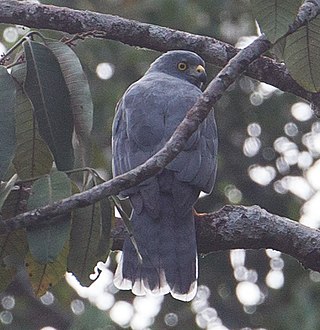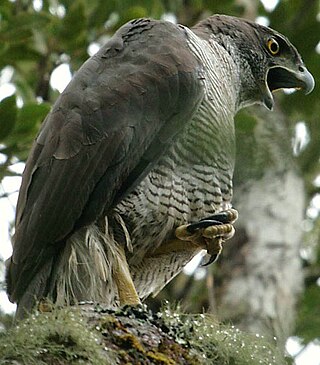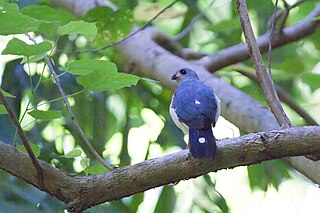
The Accipitridae is one of the four families within the order Accipitriformes, and is a family of small to large birds of prey with strongly hooked bills and variable morphology based on diet. They feed on a range of prey items from insects to medium-sized mammals, with a number feeding on carrion and a few feeding on fruit. The Accipitridae have a cosmopolitan distribution, being found on all the world's continents and a number of oceanic island groups. Some species are migratory. The family contains 256 species which are divided into 12 subfamilies and 75 genera.

The shikra is a small bird of prey in the family Accipitridae found widely distributed in Asia and Africa where it is also called the little banded goshawk. The African forms may represent a separate species but have usually been considered as subspecies of the shikra. The shikra is very similar in appearance, as well as behavior, at least to some degree, to other species including the Chinese sparrowhawk, Eurasian goshawk and Eurasian sparrowhawk. They have a sharp two-note call and exhibit the flap-and-glide flight style typical of Tachyspiza and Accipiter hawks. Their calls are imitated by drongos and the common hawk-cuckoo resembles it in plumage. This species was formerly placed in the genus Accipiter.

The besra, also called the besra sparrowhawk, is a bird of prey in the family Accipitridae. It was formerly placed in the genus Accipiter. The name "besra" is from the Hindi word for the species.

The crested goshawk is a bird of prey in the family Accipitridae that is widely distributed in tropical Asia. It was formerly placed in the genus Accipiter.

The Pacific reef heron, also known as the eastern reef heron or eastern reef egret, is a species of heron found throughout southern Asia and Oceania. It occurs in two colour morphs with either slaty grey or pure white plumage. The sexes are similar in appearance.

Frances's sparrowhawk is a small bird of prey. This species was formerly placed in the genus Accipiter. The nominate subspecies, T. f. francesiae, is endemic to Madagascar, and the other subspecies are found in the Comoro Islands. The Anjouan sparrowhawk, also known as the Anjouan Island sparrowhawk, Ndzuwani goshawk or Joanna Island goshawk, was thought to be extinct until searches in the 1980s and in 2005 confirmed that it is still extant.

The brown goshawk is a medium-sized bird of prey in the family Accipitridae found in Australia and surrounding islands. This species was formerly placed in the genus Accipiter.

The grey goshawk is a strongly built, medium-sized bird of prey in the family Accipitridae that is found in eastern and northern Australia. The white morph of this species is known as the white goshawk. This species was formerly placed in the genus Accipiter.

The Fiji parrotfinch is a species of estrildid finch endemic to Fiji that was formerly considered to be a subspecies of the red-headed parrotfinch. This parrotfinch is a small, mainly green bird with a red head and tail and a stubby dark grey bill. It is found in both forested and open habitats, and has adapted well to man-made environments such as grasslands, pasture and gardens. Pairs have a courtship display in which they fly above the trees in an undulating flight, calling constantly. Breeding birds build a domed grass nest with a side entrance, and lay a clutch normally of four white eggs. Newly hatched chicks are naked and pink, with blue balls at the upper and lower corners of the gape, and black markings inside the mouth; older fledglings resemble the adults, but lack the red head colouring. The Fiji parrotfinch eats seeds, especially of grasses, and also readily feeds on insects and nectar. It forms small flocks of up to six birds after the breeding season.

The austral snipes, also known as the New Zealand snipes or tutukiwi, are a genus, Coenocorypha, of tiny birds in the sandpiper family, which are now only found on New Zealand's outlying islands. There are currently three living species and six known extinct species, with the Subantarctic snipe having three subspecies, including the Campbell Island snipe discovered as recently as 1997. The genus was once distributed from Fiji, New Caledonia and Norfolk Island, across New Zealand and southwards into New Zealand's subantarctic islands, but predation by introduced species, especially rats, has drastically reduced their range.

The Moluccan goshawk or Halmaheran goshawk is a species of bird of prey in the family Accipitridae. This species was formerly placed in the genus Accipiter,so a lot of the information online still has its previous name.

Henst's goshawk is a species of bird of prey in the family Accipitridae. It was formerly placed in the genus Accipiter. It is a large, diurnal bird endemic to the island of Madagascar. It is an obligate forest species that occurs at very low densities on the island and is rarely seen. It can only occupy the primary and secondary forests found within the island. Its natural habitats are subtropical or tropical dry forest, subtropical or tropical moist lowland forest, subtropical or tropical moist montane forest, and plantations. It is threatened by habitat loss within Madagascar.
The imitator goshawk or imitator sparrowhawk is a species of bird of prey in the family Accipitridae. It was formerly placed in the genus Accipiter. It is found on the islands of Bougainville, Choiseul and Santa Isabel in the Solomon Islands archipelago. Its natural habitats are subtropical or tropical moist lowland forest and subtropical or tropical moist montane forest.

The black-mantled goshawk is a species of bird of prey in the family Accipitridae. It is found in the highlands of New Guinea. Its natural habitat is subtropical or tropical moist lowland forests. This species was formerly placed in the genus Accipiter.

The little sparrowhawk is a species of Afrotropical bird of prey in the family Accipitridae. It was formerly placed in the genus Accipiter. It is the smallest member of the genus Tachyspiza and forms a superspecies with the red-thighed sparrowhawk.

The spot-tailed sparrowhawk or spot-tailed goshawk is a species of bird of prey in the family Accipitridae. It was formerly placed in the genus Accipiter. It is endemic to Sulawesi in Indonesia. Its natural habitats are subtropical or tropical moist lowland forest and subtropical or tropical mangrove forest.

The gabar goshawk is a small species of African and Arabian bird of prey in the family Accipitridae.

The Fiji woodswallow is a species of woodswallow in the family Artamidae. It is endemic to most of the islands of Fiji, although it is absent from Kadavu Archipelago and the Lau Archipelago. The species was once considered a race of the white-breasted woodswallow, which breeds from Australia, New Caledonia and Vanuatu through to Borneo and the Philippines. Some authors retain it in that species.

Tachyspiza is a genus containing goshawks and sparrowhawk in the family Accipitridae. The species were formerly placed in the genus Accipiter.





















